
The Sydney Trains M sets, also referred to as the Millennium trains, are a class of electric multiple units that operate on the Sydney Trains network. Built by EDi Rail between 2002 and 2005, the first sets initially entered service under the CityRail brand on 1 July 2002 after short delays due to electrical defects. The M sets were built as "fourth generation" trains for Sydney's suburban rail fleet, replacing the 1960s Tulloch carriages and providing extra capacity on the suburban rail network. The sets currently operate on the T2 Inner West & Leppington, T3 Bankstown, T5 Cumberland, T7 Olympic Park and T8 Airport & South lines.
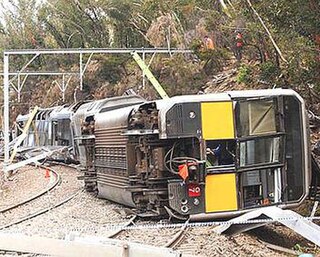
The Waterfall rail accident was a train accident that occurred on 31 January 2003 near Waterfall, New South Wales, Australia. The train derailed, killing seven people aboard, including the train driver. The accident is famously remembered by systems engineers due to the poorly designed safety systems.

The 4D was a prototype double deck electric multiple unit built for the Public Transport Corporation in Victoria, Australia, for operation on the Melbourne railway system. It remains the only double deck train to have ever operated in Melbourne. The train's name stood for "Double Deck Development and Demonstration."

The South Coast Line (SCO) is an intercity rail service operated by NSW TrainLink that services the Illawarra region of New South Wales, Australia. The service runs from Central, and runs the entire length of the eponymous South Coast railway line to Bomaderry. The service also runs along the Eastern Suburbs railway line at peak hours and the Port Kembla railway line to Port Kembla. It is operated with NSW TrainLink H sets and Sydney Trains T sets, with Endeavour railcars operating the service on the non-electrified line between Kiama and Bomaderry.

The C sets were a class of electric multiple units that operated on Sydney's suburban rail network from 1986 up until 2021. Built by A Goninan & Co between 1986 and 1987, they were introduced into service by the State Rail Authority, before later being operated under CityRail and Sydney Trains. A total of 56 carriages were built, with the last sets being withdrawn from service in February 2021, having been gradually replaced by A & B set trains.
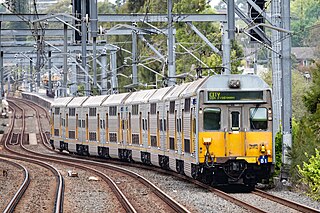
The K sets are a class of electric multiple units that currently operate on the Sydney Trains network. Built by A Goninan & Co, the K sets first entered service in 1981 operating under the State Rail Authority, and later CityRail. The carriages are of stainless steel, double deck construction and share much of their design with the older S sets. All of the 40 K sets originally built remain in service and are currently the oldest in the Sydney Trains fleet.

Kembla Grange railway station is a single-platform intercity train station located in Kembla Grange, New South Wales, Australia, on the South Coast railway line. The station serves NSW TrainLink trains travelling south to Kiama and north to Wollongong and Sydney. The station ranked equal last for patronage on the metropolitan network in 2012, and was one of 23 on the metropolitan rail network to record an average of fewer than one passenger per day in 2014.
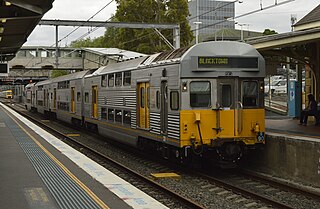
The S sets are a class of electric multiple units that operated on Sydney's suburban rail network from 1972 up until 2019. Originally entering service under the Public Transport Commission, the sets also operated under the State Rail Authority, CityRail and Sydney Trains. Prior to their retirement, the S sets were the last class in the Sydney Trains fleet to not be air-conditioned, earning them the nicknames "Tin cans" and "Sweat Sets". They were also nicknamed "Ridgys" because of their fluted ("ridged") stainless steel panelling; they shared this nickname with similar looking K sets and C sets. Their stainless steel appearance was also shared with the intercity V sets and the long retired U sets. The final sets were withdrawn from service in June 2019.
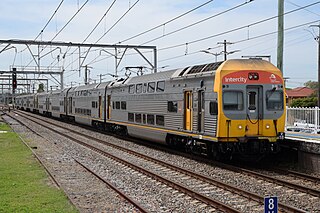
The V sets are a class of electric multiple units currently operated by NSW TrainLink. Built by Comeng between 1970 and 1989, the sets are of stainless steel construction, and are currently the oldest in the NSW TrainLink fleet. Initially introduced under the Public Transport Commission, only sets from 1977 and onwards remain in service, now operating on Intercity services to Lithgow and Newcastle.
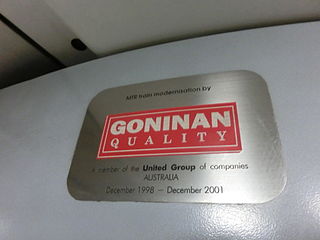
UGL Rail is an Australian rail company specialising in building, maintaining and refurbishing diesel locomotives, diesel and electric multiple units and freight wagons. It is a subsidiary of UGL and is based in Melbourne, with a staff of 1,200 across Australia and Asia. It operates factories in Broadmeadow, Maintrain Auburn, Spotswood and Bassendean. While it used to operate a factory in Taree, the plant was shut down and the equipment sold off.
The Sydney Trains fleet serves the metropolitan lines within Sydney, Australia. All of the rolling stock are double-deck electric multiple units and operate mainly as eight carriage sets.

The NSW TrainLink H sets, also referred to as the OSCAR trains, are a class of electric multiple units currently operated by NSW TrainLink. Built by UGL Rail in Broadmeadow, the H sets first entered service under the CityRail brand in December 2006, with the last in December 2012. Their introduction allowed for the retirement of some V set carriages. As long-distance trains, the H sets share a similar overall layout and design to the previous G sets. Currently operating as 55 four-carriage sets, the H sets now operate between Sydney, Central Coast and Newcastle and between Sydney and the South Coast.

The Hunter railcars, are a class of diesel multiple unit operated by NSW TrainLink on the Hunter Line in New South Wales, Australia. Built by UGL Rail between November 2006 and September 2007, they initially operated for CityRail.
The railways of New South Wales, Australia, use a large variety of passenger and freight rolling stock. The first railway in Sydney was opened in 1855 between Sydney and Granville, now a suburb of Sydney but then a major agricultural centre. The railway formed the basis of the New South Wales Government Railways. Passenger and freight services were operated from the beginning. By 1880, there was a half hourly service to Homebush.
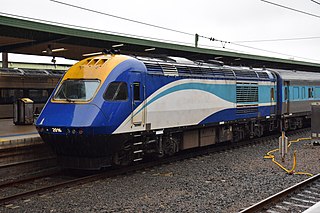
The New South Wales XPT is a class of diesel-powered passenger trains built by Comeng and ABB. Based on the British Rail-designed High Speed Train, each XPT set comprises two XP power cars in a push-pull configuration and, between them, between four and seven passenger carriages.

The U sets were a type of electric multiple unit (EMU) operated by the New South Wales Government Railways and its successors between September 1958 and November 1996. They were nicknamed U-boats.
The NSW TrainLink fleet of trains serves the areas outside Sydney, Australia, mainly interurban and interstate lines. The NSW TrainLink fleet consists of both diesel and electric traction, with the oldest of the fleet being the V sets and the youngest being the H sets.

The NSW TrainLink D sets, also referred to as the Mariyung trains, are a class of electric multiple units (EMU) being built to replace NSW TrainLink's Intercity EMU fleet. The trains will operate on services from Sydney to Newcastle, Lithgow and Kiama, allowing the retirement of NSW TrainLink's V set fleet, and freeing the H set fleet for reallocation to Sydney suburban services.

The New South Wales Bradfield suburban carriage stock were a type of electric multiple unit operated by the New South Wales Government Railways and its successors between 1921 and 1975.

The Sydney Metro Metropolis Stock is a class of electric multiple units that operate on the Sydney Metro network. Built by Alstom as part of their Metropolis family, the trains are the first fully automated passenger rolling stock in Australia as well as the first single-deck trainsets to operate in Sydney since their withdrawal from the suburban rail network in the 1990s. A total of 176 carriages, making up 22 6-car sets, entered service in 2019 with the opening of the Metro North West Line. 23 more sets are gradually being rolled out for the City & Southwest extension, to commence service in 2024, expanding the Metropolis fleet to 45 sets.



























